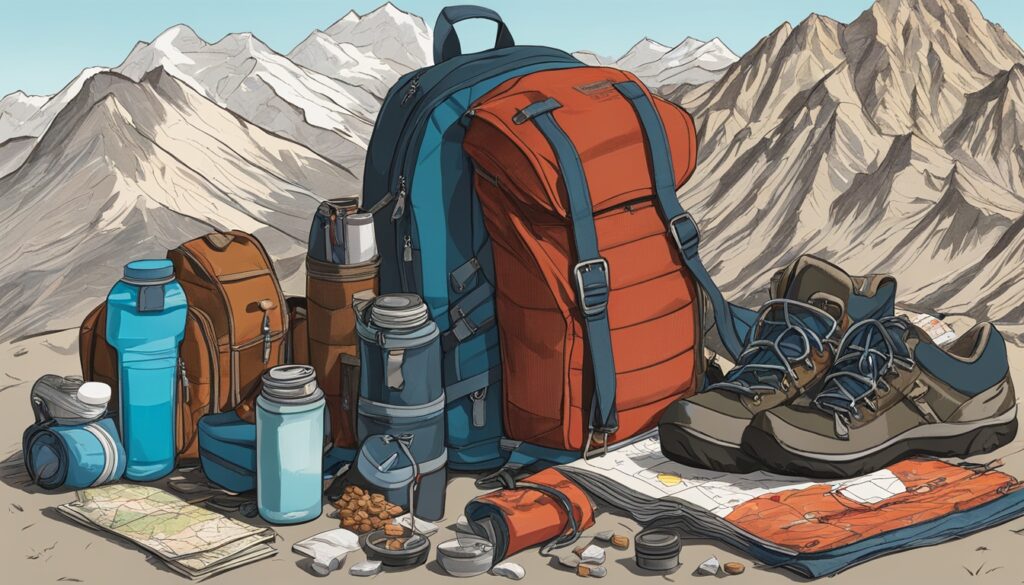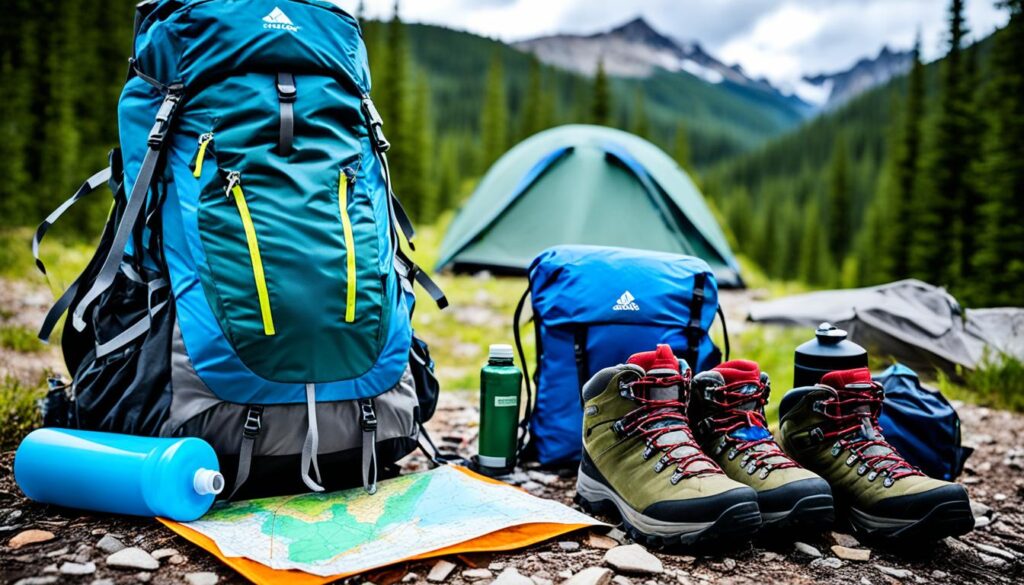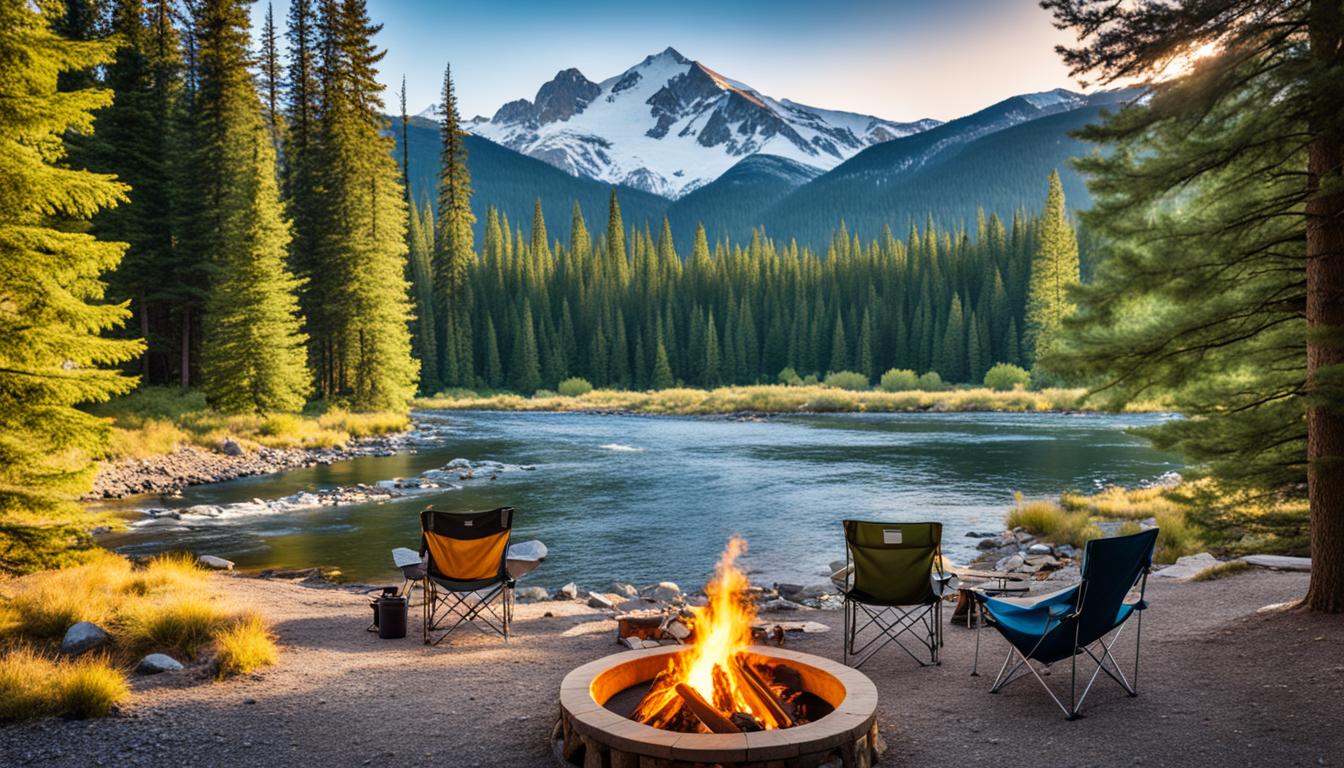Did you know that hikers with essential first aid supplies are 50% less likely to need emergency help? This fact shows how crucial it is to pack the right gear for your hike.
A good hiking checklist is like a guide for what to pack, making your hike more fun and stress-free. What you need to bring depends on the trail type, weather, season, and terrain. This guide is your ultimate list of hiking essentials, including optional items for comfort on the trail. It’s perfect for both experienced hikers and beginners, tailored to your needs for a great outdoor adventure.
Key Takeaways
- Proper preparation is crucial for a safe and enjoyable hike.
- Hiking essentials vary depending on the type and duration of the hike.
- Safety should always be the top priority when planning a hiking trip.
- Additional items can enhance comfort and convenience on the trail.
- Thorough planning is the key to a successful and memorable hiking experience.
Introduction
Starting a hiking trip needs careful planning. A detailed hiking checklist is your guide, making sure you have all the key hiking packing essentials for a smooth day hike packing list. It’s tempting to bring too much, but packing smart means finding the right balance. Too much gear can be as bad as not enough, affecting your hike.
Experts say your hiking gear should be no more than 10% of your body weight, sometimes more for safety. A daypack with a 5-kilo or 11-pound limit often needs a built-in frame for support. Merino wool is a top choice for clothing because it’s good at fighting off odors and keeping you at a comfortable temperature.
Your hiking packing essentials list should have many layers like merino tees, outerwear, pants, socks, and underwear. This way, you have extras if things get wet or worn out. Don’t forget waterproof boots/shoes, ice grips, and layers for the weather surprises.
Think of your gear as an investment because it lasts long and keeps you safe and healthy.
For your day hike packing list, always pack the basics and a first aid kit, especially in places far from pharmacies. This is key for staying safe and ready for emergencies.
Key Takeaways
Getting ready for a hike is key to having a safe and fun time. You need to pick the right gear and focus on safety. Let’s look at what you should think about to do well on the trails.
Preparation is Crucial
Creating a detailed checklist for your hike and camping is a smart move. Planning and getting the right gear helps you tackle any problems that might come up on your hike.
Essentials Vary by Hike Type and Duration
The gear you need changes based on the hike’s type, season, and length. For instance, a long hike in Sweden might need a big backpack, a light tent, and special sleeping and cooking gear. But a short day hike might only require a small pack, basic navigation tools, and water.
Safety Should Always Come First
Keeping safe is the most important thing when hiking. Make sure to pack things like first aid kits, maps, and emergency gear. These items help you deal with unexpected situations on the trail.
Additional Items Enhance Comfort and Convenience
While the must-haves are important, extra items can make your hike better. Think about bringing things like camp shoes, Buffs, and gloves. Also, consider a warm sleeping bag and a camp stove for comfort and ease.
Proper Planning Leads to a Successful Hike
Choosing the right clothes and gear is all about planning. By preparing well, you can enjoy the outdoors without worrying about missing something or facing unexpected weather.
Making a Hiking Checklist
Making a hiking checklist is key for a safe and fun outdoor trip. It’s more than just packing gear. It’s a plan that includes safety items, navigation tools, the right clothes, food, and comfort items.
A good hiking checklist helps you avoid forgetting important gear or packing too much. It acts as a safety net. It prepares you for different situations like sudden weather changes, injuries, or getting lost.
Customize your hiking checklist for the hike you’re planning. The length of the trail, the terrain, and the season will tell you what you need to bring.
- Pack at least 1 liter of water for every hour of hiking, and more on hot days.
- Carry snacks and extra food in case of delays or emergencies.
- Include a first-aid kit, headlamp, and other essential safety gear.
- Bring fire-starting tools, a repair kit, and versatile items like a bandana.
- Don’t forget communication devices like a satellite communicator or walkie-talkies.
- Pack clothing and accessories suitable for the weather and terrain.
Creating a detailed hiking checklist sets you up for a successful and worry-free outdoor adventure. Remember, good hiking planning and preparation are key for a safe and fun time on the trail.

Basic Day Hiking Essentials
Getting ready for a day hike is simple. You’ll need different items based on the trail and weather. But, there are some basic things that should always be on your list. These include the right hiking gear, hiking clothing, and hiking footwear. A good packing list can ensure a safe and fun hike.
Necessities and Emergency Gear
- First aid kit
- Reusable water bottle or hydration bladder
- Emergency shelter (e.g., space blanket, bivy sack)
- Sunscreen and sun protection
- Flashlight or headlamp
Clothing and Footwear
For hiking clothing and hiking footwear, focus on comfort and flexibility. Choose lightweight, moisture-wicking fabrics to stay dry and comfy. Here are some must-haves:
- Lightweight, breathable pants or shorts
- Moisture-wicking base layers
- Insulating mid-layer (e.g., fleece jacket)
- Waterproof and windproof outer layer
- Comfortable, supportive hiking shoes or hiking boots
- Warm, moisture-wicking socks
Hiking Equipment
Having the right hiking gear can enhance your day hike. Consider these items:
- Trekking poles for stability and support
- Repair kit with basic tools (e.g., multi-tool, duct tape)
- Knife or multi-tool for various tasks
Food and Hydration
Good hiking food and hiking hydration are key for energy and staying hydrated. Make sure to bring:
- Nutritious snacks (e.g., energy bars, trail mix)
- Lightweight, high-calorie meals (e.g., dehydrated meals, sandwiches)
- Plenty of water, at least 1 liter per person
With these essential day hike essentials, you’re ready for your next adventure. Remember, being prepared and prioritizing safety and comfort is the key to a successful hike.
What to Bring for Hiking Overnight
Going on an overnight hike means you need more gear than for a day trip. You’ll need everything from basic overnight hiking items to cookware and hygiene stuff. Packing well is crucial for a safe and comfy trip on the trail.
Overnight Hiking Gear
For overnight hikes, choose a backpack with an internal frame and hip belt. This helps spread the weight out better. Wear synthetic clothes that keep you dry and bring layers for warmth. This includes insulated leggings, a long-sleeve shirt, a sock cap, gloves, and thick socks.
Don’t forget a light shelter like a one-person tent or hammock, a sleeping pad, and a sleeping bag for the right temperature. These are key for a good night’s sleep.
Cookware and Food
For cooking on the go, bring a small camp stove, a cooking cup, waterproof matches, and a feral rod. Choose foods that are high in calories but light to carry, like dehydrated meals, energy bars, and trail mix. Plan for a hot breakfast, a cold lunch, and a hot dinner for each day you’re out.
Hygiene and Protection
Keep clean and safe with items like biodegradable toilet paper, a trowel, hand sanitizer, and bug spray. Also, remember your medications, a first aid kit, and a way to make water safe to drink. Things like sunscreen, a headlamp, and a personal locator beacon can make your hike more comfortable.
With the right gear, food, and hygiene items, you’re set for a successful and comfy overnight hike.

Navigation and Communication
Navigating through unknown hiking trails is more than just being adventurous. Being prepared is crucial for hiking navigation and communication on the trail. Having the right tools can greatly affect your hike, making it enjoyable or potentially dangerous.
Always carry a physical map and compass as a backup to electronic devices. GPS apps and devices are great for tracking and updates. But, a map and compass are essential if your tech fails or you’re in an area with no cell service.
Hiking safety is also very important. A satellite communicator or emergency device is a must in remote areas without cell coverage. These tools let you send messages, track your location, and call for help in emergencies. They give you peace of mind while hiking.
Understanding your pace in different terrains is key to good navigation. Magnetic Declination, the difference between true and magnetic north, can throw off your navigation. But, strategies like the “Path of Least Resistance” can help in navigating tough terrains.
Being prepared is the key to a safe and successful hike. With the right navigation and communication tools, you can enjoy the outdoors without worrying about getting lost or needing help.
Seasonal Considerations
Seasonal hiking requires different gear. Knowing the challenges and benefits of each season is key for a safe and fun adventure.
Spring and Summer Hiking
In spring and summer, lightweight, moisture-wicking clothing keeps you cool. Don’t forget sun protection like a wide-brimmed hat, sunglasses, and high-SPF sunscreen. Also, insect repellent keeps bugs away.
Fall and Winter Hiking
When it’s cooler, pack extra layers for warmth. This means a rain jacket, thermal underwear, a warm hat, and gloves. Hiking boots with good traction and ankle support are a must for icy trails.
Always check the weather forecast before you go. This ensures you’re ready for the conditions you’ll face. By planning for each season, your gear will be perfect for the adventure ahead.
| Season | Hiking Challenges | Hiking Benefits |
|---|---|---|
| Spring |
|
|
| Summer |
|
|
| Fall |
|
|
| Winter |
|
|
Hiking with Children and Pets
Going on trails with kids or pets needs some extra planning. It makes the trip safe and fun for everyone. Here are some tips for hiking with kids and dogs.
Hiking with Kids
For kids, bring snacks, wet wipes, and extra clothes for mud or wetness. The Junior Ranger Park Explorer program makes planning fun and educational. The Every Kid Outdoors Pass gives fourth graders and their families free access to many federal lands and waters.
Hiking with Pets
For pets, take a collapsible water bowl, waste bags, and any needed meds. Make sure to pick trails that allow pets and check if your dog can handle the hike. Being in nature can boost your pet’s health and yours too.
Whether with kids or pets, being ready is key. With the right gear and planning, you’ll make memories and grow a love for nature in your family.
| Hiking with Kids | Hiking with Pets |
|---|---|
|
|
“Just 5 minutes of walking in nature can improve mood, self-esteem, and relaxation.”
With these tips, you can have a great time hiking with your family, including pets.
Tips for Packing and Planning
Proper planning is key for a successful hike. Begin by making a detailed hiking packing tips list. Check the weather forecast to make sure you have the right gear. Practice packing and unpacking your backpack to make sure everything fits well.
Think about the length and difficulty of the hike when picking your hiking planning clothes and gear. Leave a copy of your hiking plan with someone you trust. Don’t forget to get any needed permits or passes.
By following these hiking preparation tips, you’ll have a better time and stay safe on the trail. The more you plan, the more you can enjoy the journey and the beauty around you. Take time to prepare, and your hike will be unforgettable.
FAQ
What is a well-crafted hiking checklist and why is it important?
A well-crafted hiking checklist is like a roadmap for your hike. It helps make your adventure more enjoyable and less stressful. It covers essential safety gear, navigation tools, food, clothing, and comfort items.
How does the type of hike and duration affect the hiking essentials I need to pack?
The essentials you pack can change a lot depending on the hike’s type, weather, season, and terrain. Make sure your gear list fits the hike you’re planning.
What are the most essential items I should always have in my hiking backpack?
Always carry a first aid kit, navigation tools like a map, compass, and GPS, emergency gear, water, and snacks. Safety and being prepared are key.
What are some “nice to have” items that can enhance my hiking experience?
Items like trekking poles, a repair kit, and hiking clothes and shoes can make your hike better. For overnight trips, consider a camp stove and cookware. Don’t forget hand sanitizer and bug spray for comfort and hygiene.
How should I plan and prepare for a successful hike?
Start by making a detailed packing list and checking the weather. Practice packing and unpacking your backpack. Always leave your hike plan with someone you trust. And remember to get any needed permits or passes.
















